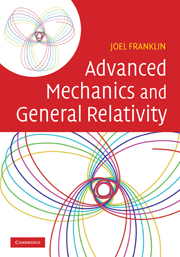8 - Gravitational radiation
Published online by Cambridge University Press: 05 June 2012
Summary
While we have not exhausted the vacuum solutions, we are about half-way done with the physically interesting ones (for point sources). So it is time for a brief interlude – radiative solutions. Our study will split into two general categories: waves in vacuum and their sources. In the linearized theory, as was mentioned in our perturbative expansion of Einstein's equation, we have a generic wave equation with and without sources – the solution to this in the tensor setting is well-defined: superimposed (because we are in the linearized limit) waves of definite frequency and two polarizations. We will be studying both the vacuum and source-driven waves predicted by GR. Gravitational waves are the basis for detection in a number of experiments, both current and planned, so it is important to understand the nature of this radiation, and the patterns generated by typical sources. Basically, though, the tools are identical to E&M with one extra polarization.
We know that the metric, as a field, is most directly comparable to the fourpotential in E&M. The potential, however, is not the physically relevant field, as is evidenced by the Lorentz force law which makes reference to the fields E and B. The same is true in general relativity – it is not the metric itself that informs physical observation – after all, at the very least, the metric is governed by Einstein's equation, which is coordinate-independent. In order to make a prediction, one must first choose a coordinate system, and then see what form the metric takes.
- Type
- Chapter
- Information
- Advanced Mechanics and General Relativity , pp. 296 - 326Publisher: Cambridge University PressPrint publication year: 2010

